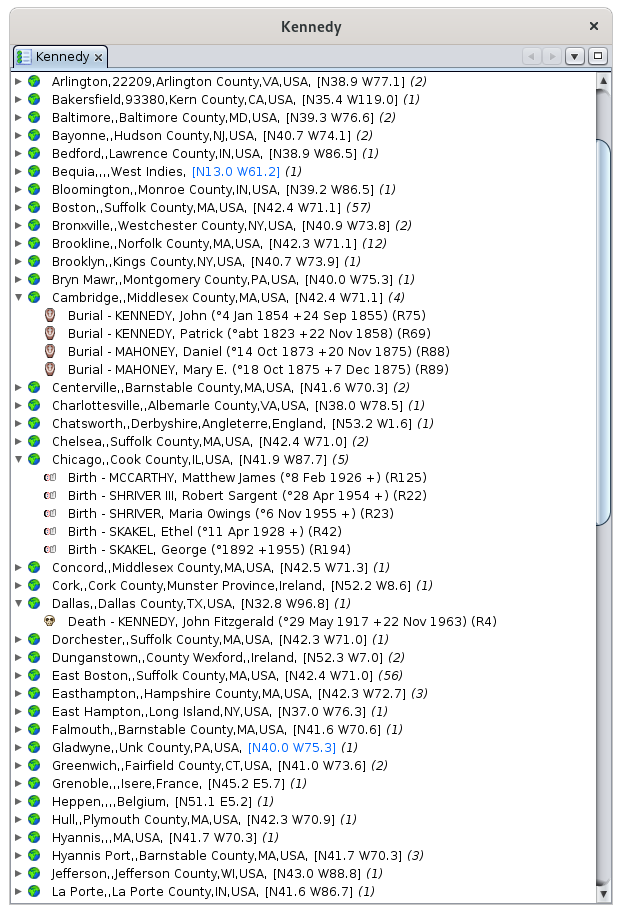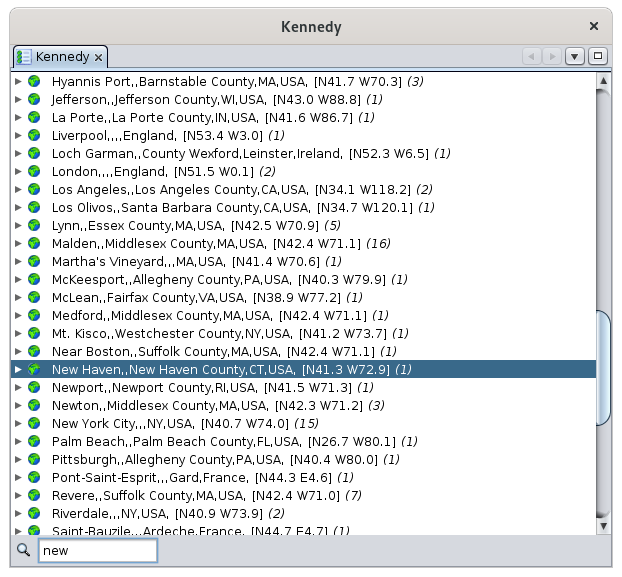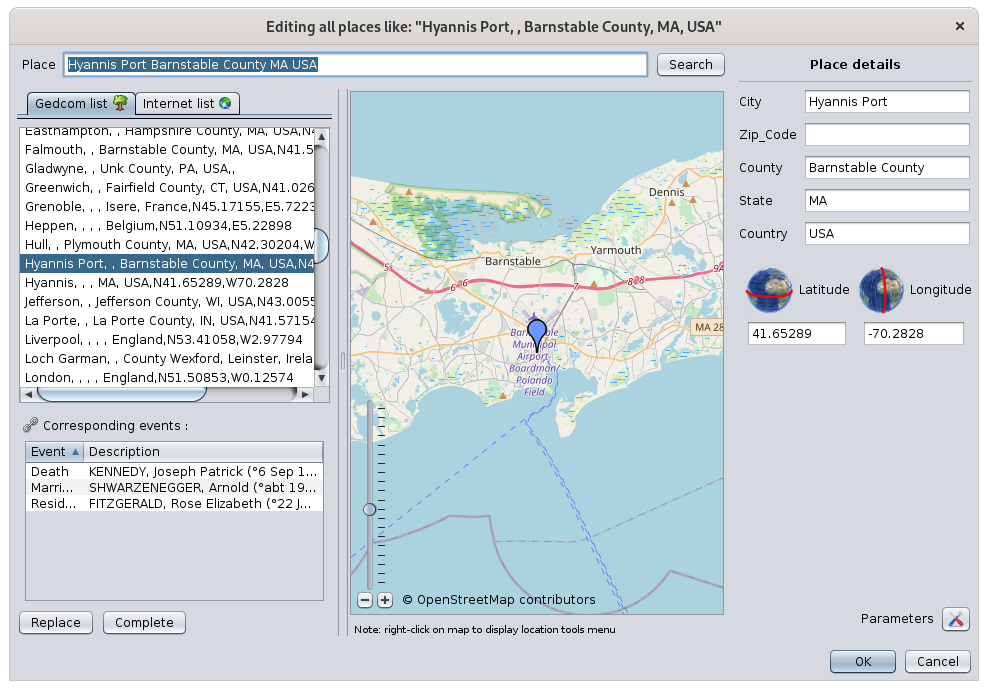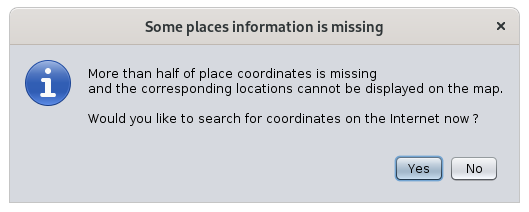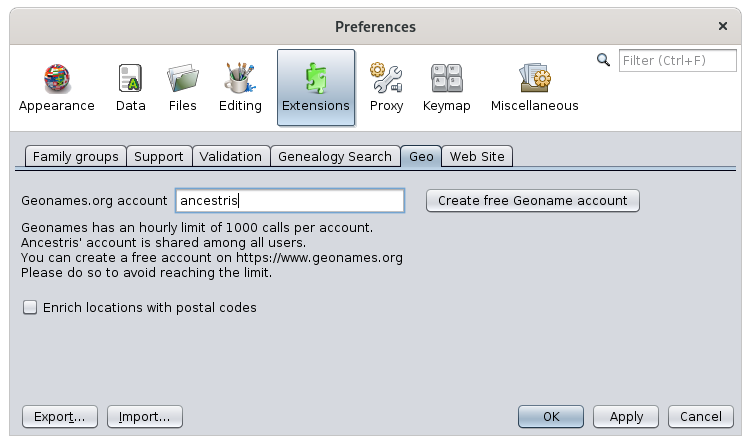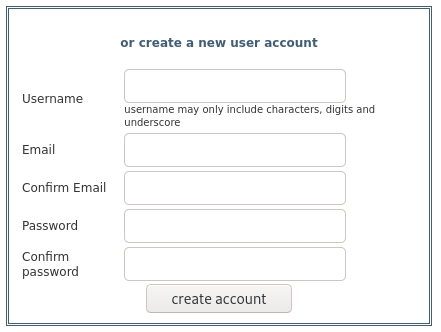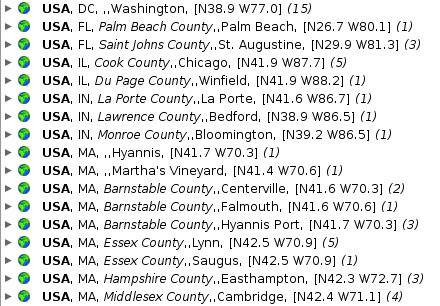List of places (L)
The List of Places is a list of all places and corresponding events of the genealogy. Each place can be modified.
All places found in the genealogy are listed, with their geographical coordinates.
For each of them, it is possible to see the events that occurred there.
The sorting of the list can be modified, as well as the display format.
It is also possible to merge places that should be identical, and to define or correct the geographical coordinates of those that are wrongly positioned.
Description
The List of Places is a two-level tree list:
- Places
- The events that occurred there
The event level can be unfolded or folded by clicking on the flap :
Places
Each place line displays the following characteristics:
- An icon whose color indicates if it could be located by Ancestris or not
- Its name
- In square brackets, its geographical coordinates
- In brackets, the number of events that occurred there
Places are sorted in alphabetical order.
Green place icons
A green place icon ![]() indicates a place that was found by Ancestris. In this case, the coordinates can be displayed in blue or black.
indicates a place that was found by Ancestris. In this case, the coordinates can be displayed in blue or black.
- Coordinates displayed in blue (example: [N40,0 W75,3]) mean that Ancestris found the coordinates of this place on the Internet.
- Coordinates displayed in black (example: [N53,2 W1,6]) mean that Ancestris found the coordinates of this place in the Gedcom file itself. You probably did save the coordinates in the Gedcom file at some point.
Sometimes, some places might not be properly located, despite the presence of the green icon. To remedy this, see the instructions below to "repair a place".
Red place icons
A red place icon ![]() indicates a place whose coordinates Ancestris did not find.
indicates a place whose coordinates Ancestris did not find.
In this case, the coordinates are always displayed in red (example: [N45,0 W4,0]).
To remedy this, see the paragraph below to "repair a place".
Events
Each event line displays its characteristics :
- The type of event in the form of its symbol (birth, marriage, occupation, etc.)
- The type of event
- The name of the individual involved in the event, followed by his or her ID number in brackets (Ixxxxx). If the event applies to a family (marriage, contract, divorce...), the line displays the name and ID number of each of the two members of this family, as well as the ID number of this family (Fxxxxx).
The different event lines are sorted alphabetically by the name of the event and the name of the individual.
The List of Places covers several needs, which are as follows, from the most frequent to the least frequent :
- Search for a place in the list, directly by typing on the keyboard the place to be searched.
ModifyAct on a place, with a right click on a place to display an actionsmenu.menu, including the modification of the place.NavigateActtoontheaneventsevent of agivenplace,fromwith a right click on an eventintothedisplaylocation.an actions menu, to select it or modify it.- Search for
thecoordinates of alllocations.locations. This is done at the first launch of thelistList ofplacesPlacesforview,a genealogy, and thenor from thegeographicalGeographic map view.
Search for a place in the list
The search for a locationplace is done by first selecting an item from the list and then typing the first letters of the jurisdictionplace you are looking for.
- A search window opens at the bottom left of the
list.list, with the search string in it. - The
selected locationfirst linemovesin the listonthat matches thefirststringoccurrenceisofthenthehighlightedentered string.automatically.
You can see above the first letters of "New York" that were entered, the search field appeared in the lower left corner, and the New Haven location line was highlighted.
In order for the search field to appear,appear when typing, select any locationplace line must first be selected.first.
The Place List allows the use of a context menu, available by right-clicking on a place line.
The following describes each of the actions in this context menu.
Show the location of this place on the map
This action activates the Map View and shows the location of the place on the map:
The same result would have been obtained by double-clicking directly on the Hyannis Port location in the list.
For more details on its use of the map, see the page dedicated to the Geographic Map.
Detail on this place searched on the Internet
This action displays various information that can be used to complete or correct the data entered from the editor:
C'est en particulier l'un des moyens pour identifier les codes INSEE des communes.
Edit this place
This action allows you to edit the location.
It is generally through there that you will pass to "repair" your premises, i.e.
- Repositioning places that are poorly or not accurately enough placed,
- find the ones that were not found (the places with red icon).
Clicking on this action opens the next window for editing a location.
Note that when this editor is called from the list of places, it allows you to edit all places with the same name and coordinates.
For more details on how to use it, see the Place Editor page.
Copy this place to replace it afterwards on another one
The interest of this action is to merge two places.
The action allows you to copy the full name with its coordinates of a first selected location to the clipboard, which will then allow you to paste it on another location using the command below.
The first place is the one you wish to keep. Copy the first one into the second one to overwrite it with the first one.
For example, I copy here the Jefferson place, which contains the event residence of Rosemary Kennedy:
Replace this place by the one previously copied
This command is the counterpart of the previous one to merge two places.
The place from which this second action is performed will be deleted.
At the time of this action, this place disappears from the list and the events that were attached to it are placed under the first place next to the events that were already there.
In the following example, if I replace the place Hyannis Port with what I have just copied:
I then find the following list of places, where Hyannis Port disappeared, and Jefferson contains 4 events resulting from the merging of the two places:
Refresh the list of places
This action forces the reclassification of the list and associated events.
In principle, modifying a location updates the list immediately, but it may be necessary to force this refresh.
Changing the display format of locations
This action allows you to customize the way the places are displayed in the list and therefore to sort them differently.
Refer to the Customization paragraph below.
After unfolding the list of events of a location, you right-click on an event and the event story menu below appears.
The following describes the actions in this menu.
Select this event
This action, also accessible by double-clicking, allows you to select the individual in all Ancestris views.
Edit this event in the Default Editor
This action opens the default editor, here it is Cygnus on the example, in order to make changes in the entity (individual or family) associated with the selected event.
You can change the default editor in the Preferences. The name in the context menu of the event will then have changed.
Help
Displays this page.
Search for coordinates of all locations
How does Ancestris find geographic coordinates?
When launching the Place List view and the Map view, Ancestris checks the presence of the geographical coordinates of the places in the genealogy concerned.
If more than half of the places do not have coordinates, Ancestris offers to retrieve them from the Internet:
If you agree, Ancestris will retrieve the geographic coordinates of all the places in your genealogy on the free geographic database https://www.geonames.org/.
This search can also be triggered from the Geographic Map using the "Search for location coordinates" button  in the toolbar.
in the toolbar.
Depending on the number of places, this may take a few minutes. The progress of the coordinates retrieval is indicated by a progress bar in the Ancestris status bar at the bottom right. This bar grows when you click on it and you can stop the process.
In case of connection problem or unavailability of geonames, you have this alert message: "Error searching on the internet. Use of the information of the places kept locally".
In the general case, the blue coordinates [N40,0 W75,3] are temporarily stored in a parameter file in the User Directory on your computer and not in the Gedcom file. The reason is that Ancestris is only proposing, it is up to you to choose the coordinates to be saved in the Gedcom file. The counterpart is that if you delete your preferences, the temporary contact information is lost and Ancestris will offer to retrieve the contact information again.
This temporary file allows you to have the contact information without necessarily being connected to the Internet. The Web Book uses it to generate the geographical map.
Most of the time, the coordinates retrieved from the Internet are the right ones. If on the other hand the place is not referenced in geonames, or if geonames proposes another similar but wrong one, you have the possibility to correct it.
 Green places but blue coordinates: proposed coordinates which remain to be confirmed by you.
Green places but blue coordinates: proposed coordinates which remain to be confirmed by you. Red places: coordinates not found. They are clearly highlighted so that they can be corrected later. In the list of locations, the locations appear in red. In the map view, they are placed in the middle of the Atlantic Ocean, at the latitude of Bordeaux and the longitude of Santander in order to attract your attention.
Red places: coordinates not found. They are clearly highlighted so that they can be corrected later. In the list of locations, the locations appear in red. In the map view, they are placed in the middle of the Atlantic Ocean, at the latitude of Bordeaux and the longitude of Santander in order to attract your attention. Empty places: empty places may not have been found. They are located first in the list of places and their marker is placed at the same place in the Atlantic Ocean.
Empty places: empty places may not have been found. They are located first in the list of places and their marker is placed at the same place in the Atlantic Ocean.
In all 3 cases, it is preferable to confirm the correct coordinates by editing the place, by right-clicking, action Edit this place.
Geonames limit reached
By default, Ancestris uses the "ancestris" account on Geonames to identify places. It is the same account for all users worldwide. Geonames has an hourly usage limit.
If you are under this limit, you will get the following message:
All you have to do is :
- create a free account on Geonames
- activate geonames web services
- indicate the identifier geonames in the ancestral options
You may reach the limit if you do an operation with many places, but in general, you should no longer be limited.
To change the geonames account, go to the preferences, Extensions pane, Geo tab:
Instead of ancestris, you will put your identifier when you have it.
To create it, click on the button "Create a free Geonames account" which corresponds to this link https://www.geonames.org/login, and you will arrive on the Geonames account creation page:
You create your personal account and a screen tells you that an email has been sent to you. Go to your emails and click on the account activation link.
Then you have to activate the geonames webservices.
To do so, log in to Geonames and go to your profile (link on the top right). It's here: http://www.geonames.org/manageaccount. At the bottom you have an area marked "Free web services".
 Click on the link and you should see this screen:
Click on the link and you should see this screen:
Finally, indicate your identifier in the preferences, Extensions pane, Geo. tab.
Customization
The only possible customization is that of the display of places.
You may indeed want to sort the places by country in this list, and from the largest to the smallest jurisdiction.
As this list is sorted alphabetically, this means that you have to display the jurisdictions in the reverse order in which they are entered.
This display order does not change your data.
Customization can be done through the contextual menu of the places:
The following window appears. For example, by default, the places are formatted in this order and without style effect: 0,1,2,3,4:
If we want to reverse the order, we will therefore enter 4,3,2,1,0. If we also want the country in bold and the County in italics, we will write this:
By clicking on OK, we get the list sorted by country with our bold and italic style effect:
This customization also affects the display of thumbnails on the map:
Indeed, the jurisdictions of the city name are not displayed in the same order as above. Please note that the title is forced bold regardless of the html style you designed.

